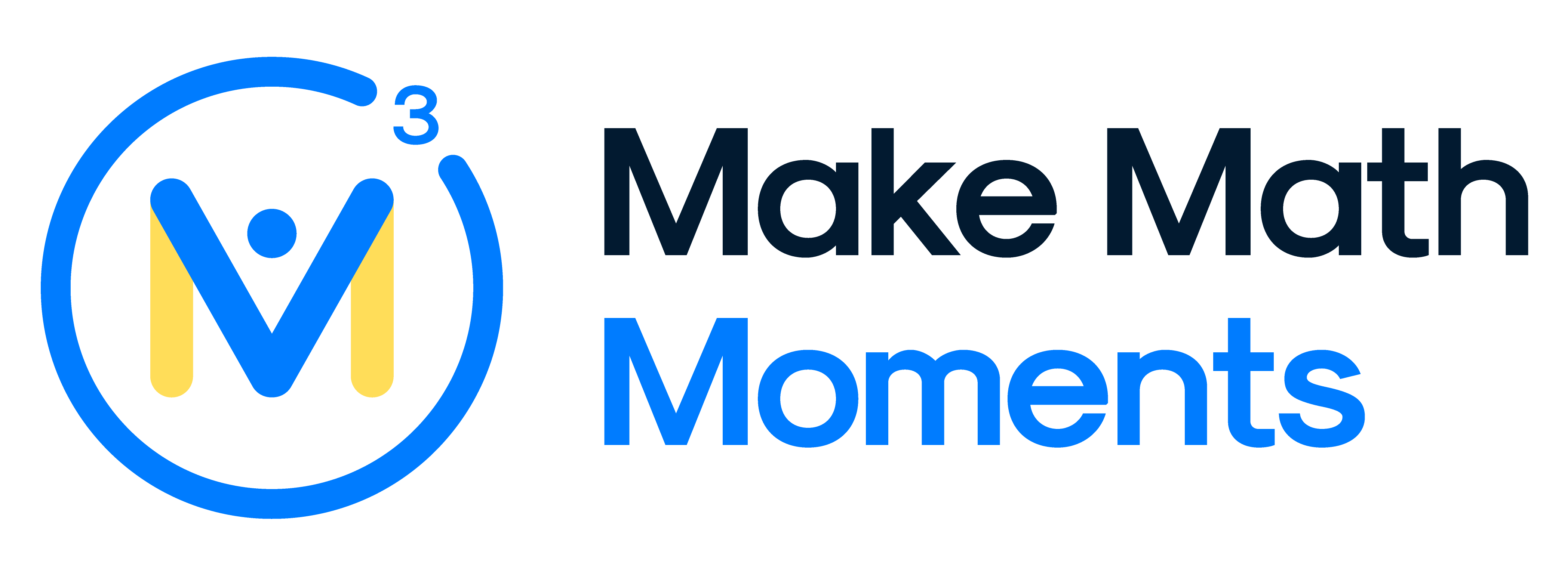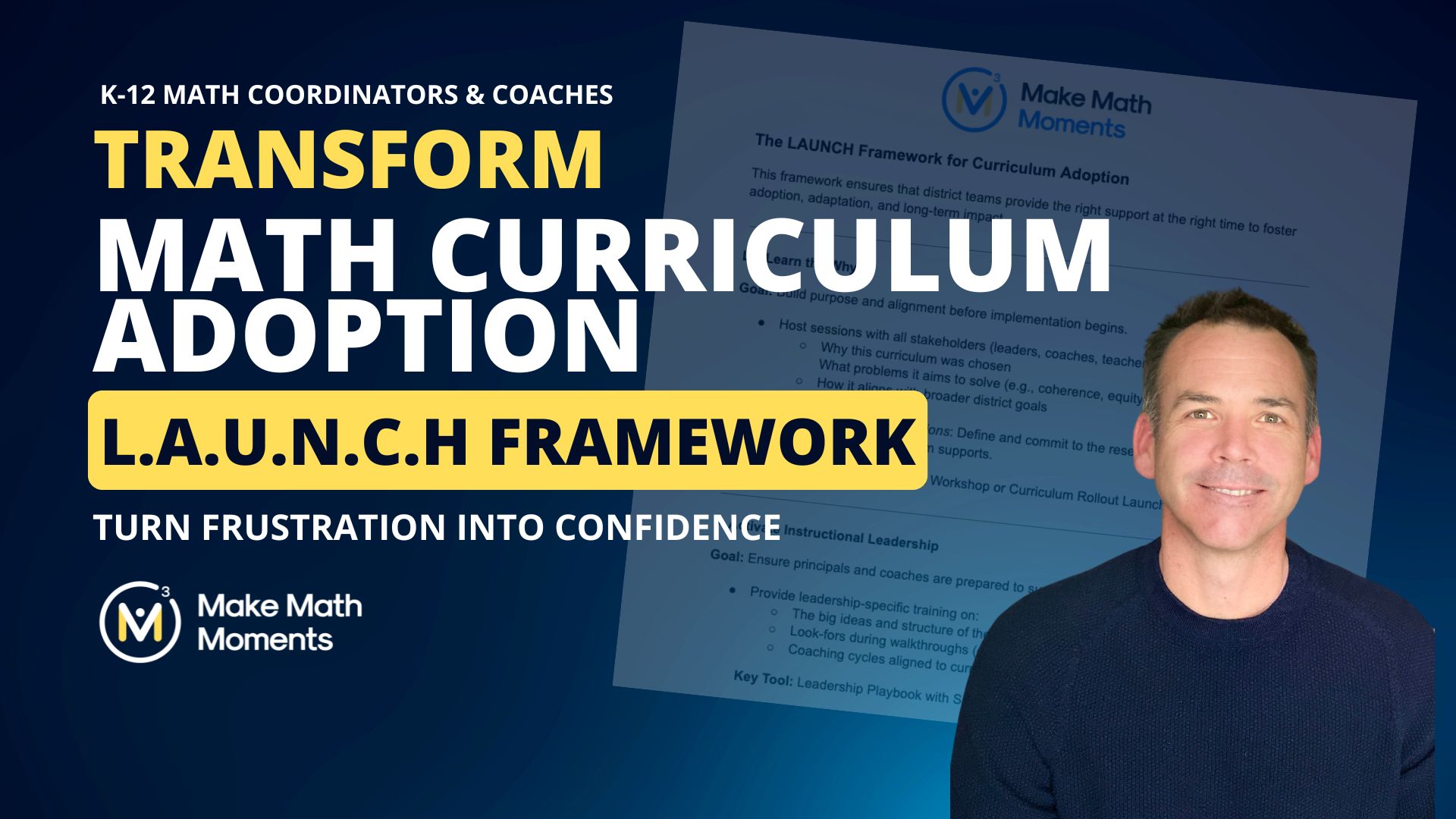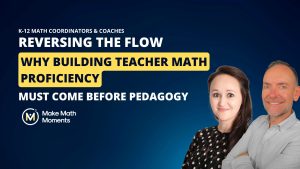Jump to the LAUNCH Framework for Math Curriculum Adoption
You know that sinking feeling when you’ve picked a shiny new curriculum and you want to believe it’s the game-changer your school needs—except deep down, you’re not sure your teachers will actually use it the way it’s designed?
That’s the conversation Jim and Kristie, two math coordinators from Ohio found themselves in. They had just adopted a curriculum aligned with the math instruction they believed in—student-centered, discourse-driven, beautifully designed to build understanding. But here’s the kicker: most of the teachers they support will find the lessons radically different than how they teach now.
It wasn’t that the curriculum wasn’t a good fit. It’s that the curriculum assumes something most new curriculum resources do: that the teachers using it already know how to facilitate meaningful discussions, make the right connections, and navigate student-led problem solving with ease.
Spoiler: most don’t. And that’s not a dig—it’s just reality.
The truth is, adopting a great curriculum means nothing if the people delivering it aren’t ready. Implementation isn’t about handing over materials—it’s about building belief, providing coaching, and supporting real instructional shifts.
You can’t assume your teachers will just “get it” because the curriculum says what to do. You also can’t just assume that they will get it because they are professional teachers. You’ve got to do the work of aligning not just the lesson plans, but the people and their deeper understanding of mathematics.
Most school leaders think picking the right curriculum is the hard part. But what if that’s the easy part?
The real challenge comes after—the resistance from veteran teachers who are used to doing things one way. The overwhelm from new teachers who don’t know where to begin. The limited time. The lack of PD. The meetings that turn into glorified “what page are you on?” check-ins.
And if you’re feeling all of that… you’re not alone.
That’s why we helped Jim and Christie break down exactly what their curriculum is assuming about their teachers—and where those gaps in practice actually are. We mapped out how to bridge the divide between vision and day-to-day classroom reality, so their teachers don’t just “follow the script”—they actually understand the math and feel confident leading students through it.
It wasn’t about changing the resource. It was about changing how their team supports the resource.
If your curriculum rollout feels more like a curriculum rollover, you’re not failing—your system just isn’t set up for success yet. Let’s fix that. Use the LAUNCH framework for Curriculum Adoption.
The LAUNCH Framework for Curriculum Adoption
This framework ensures that district teams provide the right support at the right time to foster adoption, adaptation, and long-term impact.
L – Learn the Why
Goal: Build purpose and alignment before implementation begins.
- Host sessions with all stakeholders (leaders, coaches, teachers) to clarify:
- Why this curriculum was chosenWhat problems it aims to solve (e.g., coherence, equity, thinking)
- How it aligns with broader district goals
- Anchor in Principles to Actions: Define and commit to the research-based teaching practices that the curriculum supports.
Key Tool: Vision Alignment Workshop or Curriculum Rollout Launch Session
A – Activate Instructional Leadership
Goal: Ensure principals and coaches are prepared to support consistent implementation.
- Provide leadership-specific training on:
- The big ideas and structure of the curriculum
- Look-fors during walkthroughs (e.g., student thinking, use of tools, discourse)
- Coaching cycles aligned to curriculum modules
Key Tool: Leadership Playbook with Sample PD Agendas and Observation Tools
U – Understand Through Experience
Goal: Give teachers hands-on experience with upcoming lessons before they teach them.
- Use unit pre-briefs and lesson study-style protocols:
- Teachers explore math tasks, anticipate student responses, and analyze alignment to math goals
- Prioritize doing the math and reflecting on pedagogy
Key Tool: Monthly Curriculum Study Protocol or Launch-Lead-Learn PD cycle
N – Normalize Early Struggles
Goal: Reduce fear and frustration by naming the learning curve.
- Set the tone that new implementation ≠ mastery
- Highlight teacher “glows and grows” during PLCs
- Capture and share stories of iterative improvement
Key Tool: “First 90 Days” Reflection Guide + Peer Story Spotlights
C – Coach with Purpose
Goal: Focus coaching support where it will move the needle most.
- Prioritize:
- Planning support around lesson routines and rich tasks
- Co-teaching in high-leverage moments (e.g., launches, consolidations)
- Feedback cycles that are specific and actionable
Key Tool: Curriculum Coaching Cycle Template with Focused Look-Fors
H – Highlight & Scale What’s Working
Goal: Sustain momentum by spotlighting success and building collective efficacy.
- Use walkthrough data, student work, and video to show progress
- Host teacher-led showcases or cross-school lesson studies
- Adapt and adjust based on teacher feedback
Key Tool: Mid-Year Curriculum Reflection + Bright Spots Gallery Walk
Want to get ahead of the rollout curve?
Start by using our Math Curriculum Readiness Reflection Tool to assess whether your current support systems are setting teachers up for success. You’ll walk away with clarity on where the biggest gaps are—and which piece of the LAUNCH framework to activate first.
👉 [Click here to get the free reflection tool]






